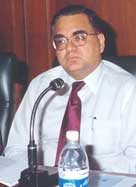|
Kolkata: One of the reasons for India's increasing fiscal deficit is that the growing services sector is outside the tax net, says Dr Parthasarathi Shome, the director of the International Monetary Fund's Singapore Training Institute. ''Although the services sector is one of the fastest growing sectors of the economy, it is not adequately taxed and not fully covered by the tax net,'' he says. Shome was in Kolkata recently to attend a meet organised by the Indian Chamber of Commerce, where he talked about his analysis of the Indian fiscal scene as published in his latest book India's Fiscal Matters. The book discusses India's fiscal situation threadbare and gives prescriptions on how to streamline the taxation system in the country. It also deals with lessons from international experiences, value-added tax (VAT), tax policy and administration.  Because of the non-performance of the manufacturing sector and central public sector units, government revenue from income tax has failed to rise substantially, says Shome. ''Despite the expansion of the income tax net, income tax has not made up the losses of indirect taxes. Due to modvat and credit mechanisms, the tax component on excise and customs duty has gone down.'' Because of the non-performance of the manufacturing sector and central public sector units, government revenue from income tax has failed to rise substantially, says Shome. ''Despite the expansion of the income tax net, income tax has not made up the losses of indirect taxes. Due to modvat and credit mechanisms, the tax component on excise and customs duty has gone down.''
According to Shome, India could have gone the way of Argentina, but was saved by the fact that most of India's public debt is rupee-denominated and hence carries no exchange risk. At present, public debt has reached two-thirds of the country's gross domestic product (GDP). The mounting interest burden
Shome says over the last decade, the decline in the central government's revenue performance in terms of the GDP has been driven by tax revenue, which has gone down by 1 per cent of the GDP. The increasing interest burden has coexisted with diminishing expenditure, both Plan and non-Plan. The fiscal deficit of the central government has shown no clear declining trend over the 1990s. ''We are getting increasingly burdened with the expenditures of yesterday,'' he points out. ''The non-Plan expenditure has exceeded total receipts, indicating a rise in consumption. In the mid-1990s, interest payments exceeded Plan expenditure. Within the Plan expenditure too, the capital part is falling short of the revenue part.'' Since 1997-98, the ratio of the Centre's fiscal deficit to its GDP has further worsened. In fact, states suffered a revenue decline in terms of the GDP over the past decade, reflecting a steady decline in tax revenue, he adds. ''Non-tax revenue improved till 1994-95, but then declined to earlier levels.'' Indians are good savers, but the savings are not invested efficiently, leading to poorer returns, Shome says. He emphasises that inter-state taxation should be based on the destination principle, since VAT is a consumption tax. ''Currently, the origin principle prevails, under which the exporting state keeps the revenue.'' The fiscal report card
Shome's analysis reads like a report card on the country's fiscal situation. Some of the points highlighted are: - Bringing down customs tariff rates to internationally comparative levels remains a challenge
- A greater challenge is streamlining exemptions from the (Customs Cooperation Council Nomenclature) CCCN code. They suffer from extreme complexity and result in non-transparency in administration, economic distortions and poor revenue productivity
- There has been palpable progress in restructuring the central excise rate structure and minimising taxation of inputs
- Existing leakages from the excise tax base through exemptions pose a major problem. A major medium-term challenge remains the coordination of central excises (Cenvat) with a state-level VAT with the objective of structuring a national VAT
- Individual and corporate income tax rates have been significantly reduced and revenue performance has improved in terms of the GDP
- For individual taxpayers, tax incentives for savings should be given mainly in the form of tax credit. Some sections like section 80L should be removed and others like section 10 should be streamlined. The investment ceiling for tax credit (section 88) should be appropriately raised, reflecting any cost-of-living increase
- The corporate tax structure should enable expansion of the number of taxpaying companies. A reformulation of the minimum alternate tax (MAT) is needed
- The tax administration needs strengthening
Subsidies should not usually be tolerated
Shome also feels that the government's expenditure needs to be curtailed. ''The central government's wage bill should be reduced by cutting government employment by a tenth. Subsidy should be tolerated only if given in the final step such as midday meals. But a subsidy in power was not justified and created pricing-related problems. Bringing down corporate tax rates is preferable to giving subsidies to industry.'' A strong case for decentralisation
Shome points out that the performance of individual states in terms of their fiscal deficit-to-GDP ratio has not changed over the past decade. This indicated that the Centre's revenue sharing and redistribution across states has not necessarily encouraged states to improve their performance. He says his studies show that that there is an empirical relationship between higher decentralisation and higher economic growth and higher decentralisation and lower fiscal deficit. ''Therefore, to reduce the consolidated fiscal deficit of the central government, further decentralisation should take place in the form of amplified tax assignment to states. This would provide greater freedom to states to collect their own revenue. While this would imply a smaller revenue sharing pool at the Centre in its redistribution, the Centre should give higher weight to the income criterion, thus protecting poorer states.'' Shome says modern India needs to take a leaf out of the timeless work Arthashastra, in which Kautilya wrote on the importance of increasing savings and curbing expenditure to sustain the economy. ''This diktat holds true even after 2000 years.
|